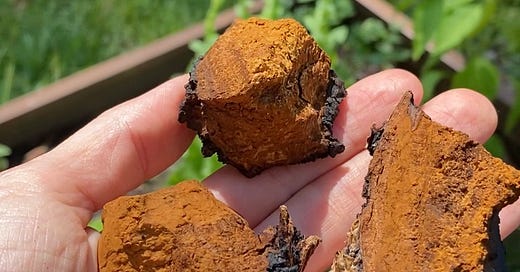I don’t know how I found Chaga or how Chaga found me, but I do know that I’ve had a love affair with this fungi for a couple of years now. This is surprising because Chaga may be one of the ugliest-looking things I’ve ever eaten.

Chaga doesn’t grow where I live. It prefers cold climates, like the northern United States, Canada, Russia, and northern Europe. But what exactly is Chaga? Is it a mushroom? No, not exactly. Chaga, Inonotus obliquus, looks like a grotesque-looking burnt mass when growing on its host tree, usually a birch. This mass is a sclerotium, a harden form of mycelium. Mycelium is a network of fungal threads, whereas mushrooms are the fruiting body of a fungi—the fungi’s flowers. Chaga then, as we consume it, is a sclerotium.
To harvest, the sclerotium is cut off the tree and left out to dry. It is then chopped up into golf-ball sized chunks. The inside of the Chaga reveals a glowing coppery-orange color. This is the beauty part. That color indicates impressive health benefits.
I drink Chaga mostly for cancer prevention and its ability to suppress tumor growth.
From the Lost Book of Herbal Remedies:
“Chaga helps prevent and treat cancer through increased antioxidant activity, by slowing or stopping the growth of the cancerous tissue and metastasis to other parts of the body, by killing off existing cancerous cells and reducing tumors, through boosting the immune system, and by helping eliminate cancer cells from the body.”
Chaga’s health benefits extend further. Chaga also:
*Helps reduce oxidative stress
*Is a powerful adaptogen, which means that it helps the body adjust to changing conditions
*Helps lower cholesterol
*Lowers blood sugar
*Protects the liver
*Protects the gastrointestinal tract
*Is a powerful anti-inflammatory, and boosts the immune system with its antioxidant properties
*Is an Anti-Viral, protecting against the flu and other viral infections.
info from “The Fungal Pharmacy,” by Robert Rodgers
and “The Lost Book of Herbal Remedies,” by Nicole Apelian
Some may prefer a tincture of Chaga. I like to make a Chaga tea that I can sip all week. While tinctures are excellent in extracting medicinal compounds, teas allow the plant or fungi’s vitamins and nutrients to be consumed as well. To get the full healing benefits of Chaga as a tea, it needs to be decocted, but this simply means that it must be cooked in water to extract the medicinal properties.
To make Chaga tea:
Place a Chaga chunk it in a big pot of water. How much water depends on how much tea you would like to make.
Bring water to a boil.
After it begins boiling, turn the heat down to low, place a lid on top, and let it continue to decoct. The longer, the better. If I’m making a small batch that I will drink immediately when it is done, I’ll let it simmer for 30 minutes. If I’m making a large batch or one that I will drink later, I let it simmer longer—two hours or more. Sometimes, I put the Chaga in the crock pot with water and cover and let it cook all day on low. This is an easy method that you don’t have to think about!
When the Chaga has been decocted long enough, it will be a dark color and you will notice a sheen to the top of the liquid, kind of like what oil looks like on top of water. This is a sign that you’ve cooked it well enough to extract some of the best phytochemical compounds.
Once done, simply pull out the Chaga chunk and it’s ready to drink. You can drink the Chaga hot or put it in the fridge and drink it cold later. Chaga makes a full-bodied tea with an earthy taste that is clean on the palate. I find it comforting as a hot beverage and refreshing as a cool one.
You can save your Chaga chunk and let it dry out again to make another batch. I can usually get two batches out of one chunk of Chaga.
Lastly, here’s where to buy Chaga:
Since it is a wildcrafted product, check that you are buying from a person/company with integrity. Always trust your gut instinct about whether a company is ethical or not. I’ve found Chaga from sellers on Etsy. I’ve also bought Chaga from Birch Boys.
An ethical wildcrafter will:
follow the rule of thirds and take no more than 1/3 of any plant that is available. Some foragers suggest taking even less.
walk lightly in nature
ask the plant/ fungi’s permission before taking. I realize that to some this may sound silly, but think of it as a way of showing respect.
thank the plant /fungi after harvesting. Think of this like a prayer of gratitude.
I buy the big chunks of Chaga to make my tea. Some suppliers sell smaller pieces, but I find them harder to save and reuse. As for Chaga powders, I find that they usually sink to the bottom of my mug and are messy. It doesn’t make for a clean drink.
A word on supplements: Because Chaga must be decocted, I am skeptical if one gets the full range of benefits from Chaga supplements as they do with Chaga tea, but I encourage you to do your own research. Please share with me any research you may have that says otherwise!
With Chaga’s health benefits, it’s always important to check with your own doctor and do your own research as well to make sure it is safe for you and your body’s uniqueness.
What do you think? Is Chaga something you will try or am I preaching to the fungi choir? Let me know in the comments!
Xo,
Katie





It grows everywhere up here! I still haven't tried to do anything with it but I'm intrigued.
Such great info!